Jim Walker of Cruise Law News writes the Centers for Disease Control (CDC) reports that there was a gastrointestinal outbreak on the Crown Princess during its recent cruise, from October 25th to November 8, 2017. The Princess cruise ship departed Quebec, Canada on October 25th for a two-week cruise to Canadian and U.S. ports. The cruise ship arrived in Fort Lauderdale, Florida on November 8th and will begin its Caribbean season.
 According to the CDC report, 184 passengers and 12 crew members became ill with gastro-like symptoms which included diarrhea.
According to the CDC report, 184 passengers and 12 crew members became ill with gastro-like symptoms which included diarrhea.
During the period from 2010 to the current date, Princess Cruises experienced the most outbreaks on its cruise ships calling on U.S. ports, according to the CDC. Princess reported twenty-one (21) cases to the CDC during this time period.
The Crown Princess alone has suffered through six (6) norovirus outbreaks since 2010 to the present. Before the current GI outbreak, the last norovirus outbreak on the Crown Princess was from January 3 – 18, 2016 and, before that, from October 18 to November 16, 2014. Earlier, there was a norovirus and e-coli outbreak from February 5 to 12, 2014. It also experienced back-to-back norovirus outbreaks from January 29 to February 4, 2012 and February 4 to February 9, 2012.
The cruise line with the second most outbreaks is Holland America Line with 18 cases of GI sicknesses reported to the CDC since 2010. HAL suffered norovirus outbreaks on the Nieuw Amsterdam, and two outbreaks each on the Voendam and the Noordam this year.
So why is Princess Cruises far more prone to norovirus outbreaks than Carnival cruise lines, for example?
The cruise industry always blames the passengers for bringing the virus aboard, rather than its food handlers, or contaminated food or water. So are Princess Cruises customers the sickest and the least hygienic cruisers around? Are guests of HAL the second most unhygienic cruisers? Do they wash their hands the least of any cruisers? This seems like absurd arguments to make.
Whoever is to blame, the crew members, of course, always pay the price, by having to wipe and scrub and spray everything in sight for long 16+ hour days to try to disinfect a ship longer than three football fields.
Irrespective of the blame-game, don’t call us if you get sick on a cruise. Proving where the virus came from, or that the cruise line was negligent, is virtually impossible to prove, especially since the CDC conducts no epidemiological analysis and sometimes can’t even figure out whether the outbreak is due to norovirus, e-coli or something as exotic as Shigella sonnei or Cyclospora cayetanensis.
 For example, The New Zealand Herald reports, a passenger on a cruise ship plagued with a vomiting and diarrhoea bug says he only learnt previous guests had been struck down with the same thing once they set sail.
For example, The New Zealand Herald reports, a passenger on a cruise ship plagued with a vomiting and diarrhoea bug says he only learnt previous guests had been struck down with the same thing once they set sail.
Sydney man Walter Gibian and his wife Elisabeth left Sydney on October 30 on a 12-day Celebrity Solstice cruise travelling from Sydney to Auckland via the South Island so they could see New Zealand. Gibian had worked in New Zealand in 1980s and loved it so booked the cruise to see the East Coast.
The ship had left Melbourne when the captain announced to guests that passengers on an earlier cruise had norovirus and asked guests to take extra precautions including washing their hands regularly and using hand sanitiser.
any notification before they left and by this time it was too late to do anything about it as they were well on their way to New Zealand.
“It think people should be told and given the option that if you don’t like being exposed to this virus you are allowed to get off. But we found out when we were sea.”
Halfway into the 12-day cruise passengers started falling ill and Elisabeth came down with the bug on Saturday night. She was then isolated to her cabin for 48 hours.
“They (passengers) are sick all right. But of course the ship won’t tell us how many are sick, but my wife got sick on Saturday night. They are taking all sorts of precautions but it is still happening. They keep telling me, they are doing their utmost and they are doing their best but the fact is it is not effective.”



.jpeg) another outbreak sent two Fredericton teenagers to hospital and sickened at least another two people.
another outbreak sent two Fredericton teenagers to hospital and sickened at least another two people..jpg) the fault of consumers, not farmers?
the fault of consumers, not farmers?(1).jpg) synthesis, contains a greatest hits of microbial food safety myths.
synthesis, contains a greatest hits of microbial food safety myths..jpg) lettuce and spinach were already washed in a sanitizing solution at the packing plant and it was probably a lot cleaner than your kitchen. Microorganisms bond to the surface of the food item. "You are not going to rinse them off, it simply won’t happen, they cannot be washed off.”
lettuce and spinach were already washed in a sanitizing solution at the packing plant and it was probably a lot cleaner than your kitchen. Microorganisms bond to the surface of the food item. "You are not going to rinse them off, it simply won’t happen, they cannot be washed off.”